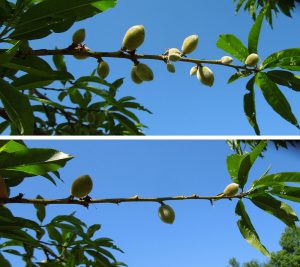Thinning Fruit

When conditions are good for bloom and pollination, trees can bear an excess number of fruit, which is a strain on the health and hardiness of the tree. In addition, limbs may not have the structural strength to support the weight of all the fruit and could break or snap off the tree near harvest time. To counteract this problem, some of the fruit should be removed in mid to late June, but fruit thinning in July will also be beneficial. Thinning fruit early in their development will benefit the tree more than removing them close to harvest time.
The amount of fruit to remove depends on the type of tree and how many fruit it currently bears. For peach, remove enough fruit so that there is no more than one fruit for every eight inches of shoot length. This is usually one or two fruit on each shoot. Plums can carry twice as many fruit as peach. Pears and apples bear fruit in clusters. It is a common practice to remove all but one fruit in each cluster.
Chemical thinning is an option for large apple orchards which are time consuming to thin by hand. Spraying carbaryl (Sevin™ insecticide) once or twice in the four weeks following bloom is an effective way to thin apple fruit, but avoid spraying when trees are in bloom or bees are present in the orchard. Two weeks after applying carbaryl, some of the fruit will be shed from the tree. For effective thinning and safety precautions, read and follow the instructions on the product package or label. Carbaryl does not thin peach or plum fruit. For more instructions on spraying, see the section entitled “Spraying Fruit Trees.”
